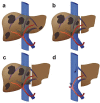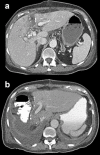Assessment of Liver Function Using (99m)Tc-Mebrofenin Hepatobiliary Scintigraphy in ALPPS (Associating Liver Partition and Portal Vein Ligation for Staged Hepatectomy)
- PMID: 26675783
- PMCID: PMC4677725
- DOI: 10.1159/000441385
Assessment of Liver Function Using (99m)Tc-Mebrofenin Hepatobiliary Scintigraphy in ALPPS (Associating Liver Partition and Portal Vein Ligation for Staged Hepatectomy)
Abstract
ALPPS (associating liver partition and portal vein ligation for staged hepatectomy) is a new surgical technique for patients in whom conventional treatment is not feasible due to insufficient future remnant liver (FRL). During the first stage of ALPPS, accelerated hypertrophy of the FRL is induced by ligation of the portal vein and in situ split of the liver. In the second stage, the deportalized liver is removed when the FRL volume has reached ≥25% of total liver volume. However, FRL volume does not necessarily reflect FRL function. (99m)Tc-mebrofenin hepatobiliary scintigraphy (HBS) with SPECT-CT is a quantitative test enabling regional assessment of parenchymal uptake function using a validated cut-off value for the prediction of postoperative liver failure (2.7%/min/m(2)). This paper describes the changes in FRL function and FRL volume in a 79-year-old patient diagnosed with metachronous colonic liver metastases who underwent ALPPS. We have observed a substantial difference between the increase in FRL volume and FRL function suggesting that HBS with SPECT-CT enables monitoring of the FRL function and could be a useful tool in the timing of resection in the second stage of the ALPPS procedure.
Keywords: 99mTc-mebrofenin hepatobiliary scintigraphy; ALPPS (associating liver partition and portal vein ligation for staged hepatectomy); Monitoring of liver function; Postoperative liver failure.
Figures



Similar articles
-
Contribution of hepatobiliary scintigraphy in assessing ALPPS most suited timing.Updates Surg. 2017 Sep;69(3):411-419. doi: 10.1007/s13304-017-0481-5. Epub 2017 Aug 9. Updates Surg. 2017. PMID: 28795384
-
Comparison of functional and volumetric increase of the future remnant liver and postoperative outcomes after portal vein embolization and complete or partial associating liver partition and portal vein ligation for staged hepatectomy (ALPPS).Ann Transl Med. 2020 Apr;8(7):436. doi: 10.21037/atm.2020.03.191. Ann Transl Med. 2020. PMID: 32395480 Free PMC article.
-
Impact of split completeness on future liver remnant hypertrophy in associating liver partition and portal vein ligation for staged hepatectomy (ALPPS) in hepatocellular carcinoma: Complete-ALPPS versus partial-ALPPS.Surgery. 2017 Feb;161(2):357-364. doi: 10.1016/j.surg.2016.07.029. Epub 2016 Sep 3. Surgery. 2017. PMID: 27596751
-
Chance and challenge of associating liver partition and portal vein ligation for staged hepatectomy.Hepatobiliary Pancreat Dis Int. 2019 Jun;18(3):214-222. doi: 10.1016/j.hbpd.2019.04.006. Epub 2019 Apr 24. Hepatobiliary Pancreat Dis Int. 2019. PMID: 31056484 Review.
-
Associating liver partition and portal vein ligation for staged hepatectomy: the current role and development.Hepatobiliary Pancreat Dis Int. 2017 Feb;16(1):17-26. doi: 10.1016/s1499-3872(16)60174-1. Hepatobiliary Pancreat Dis Int. 2017. PMID: 28119254 Review.
Cited by
-
Dynamic Evaluation of Liver Volume and Function in Associating Liver Partition and Portal Vein Ligation for Staged Hepatectomy.J Gastrointest Surg. 2017 Jun;21(6):967-974. doi: 10.1007/s11605-017-3389-y. Epub 2017 Mar 10. J Gastrointest Surg. 2017. PMID: 28283924 Free PMC article.
-
Liver function declines with increased age.HPB (Oxford). 2016 Aug;18(8):691-6. doi: 10.1016/j.hpb.2016.05.011. Epub 2016 Jun 20. HPB (Oxford). 2016. PMID: 27485064 Free PMC article.
-
Hypertrophy and Liver Function in ALPPS: Correlation with Morbidity and Mortality.Visc Med. 2017 Dec;33(6):426-433. doi: 10.1159/000479477. Epub 2017 Dec 4. Visc Med. 2017. PMID: 29344516 Free PMC article. Review.
-
Current Modalities for the Assessment of Future Remnant Liver Function.Visc Med. 2017 Dec;33(6):442-448. doi: 10.1159/000480385. Epub 2017 Nov 30. Visc Med. 2017. PMID: 29344518 Free PMC article. Review.
-
Rat Model of the Associating Liver Partition and Portal Vein Ligation for Staged Hepatectomy (ALPPS) Procedure.J Vis Exp. 2017 Aug 14;(126):55895. doi: 10.3791/55895. J Vis Exp. 2017. PMID: 28829432 Free PMC article.
References
-
- Schnitzbauer AA, Lang SA, Goessmann H, Nadalin S, Baumgart J, Farkas SA, Fichtner-Feigl S, Lorf T, Goralcyk A, Horbelt R, Kroemer A, Loss M, Rummele P, Scherer MN, Padberg W, Konigsrainer A, Lang H, Obed A, Schlitt HJ. Right portal vein ligation combined with in situ splitting induces rapid left lateral liver lobe hypertrophy enabling 2-staged extended right hepatic resection in small-for-size settings. Ann Surg. 2012;255:405–414. - PubMed
-
- Schadde E, Schnitzbauer AA, Tschuor C, Raptis DA, Bechstein WO, Clavien PA. Systematic review and meta-analysis of feasibility, safety, and efficacy of a novel procedure: associating liver partition and portal vein ligation for staged hepatectomy. Ann Surg Oncol. 2015;22:3109–3120. - PubMed
-
- Bertens KA, Hawel J, Lung K, Buac S, Pineda-Solis K, Hernandez-Alejandro R. ALPPS: challenging the concept of unresectability – a systematic review. Int J Surg. 2014;13C:280–287. - PubMed
-
- Cieslak KP, Runge JH, Heger M, Stoker J, Bennink RJ, van Gulik TM. New perspectives in the assessment of future remnant liver. Dig Surg. 2014;31:255–268. - PubMed
-
- de Graaf W, van Lienden KP, van Gulik TM, Bennink RJ. (99m)Tc-mebrofenin hepatobiliary scintigraphy with SPECT for the assessment of hepatic function and liver functional volume before partial hepatectomy. J Nucl Med. 2010;51:229–236. - PubMed
Publication types
LinkOut - more resources
Full Text Sources
Other Literature Sources

